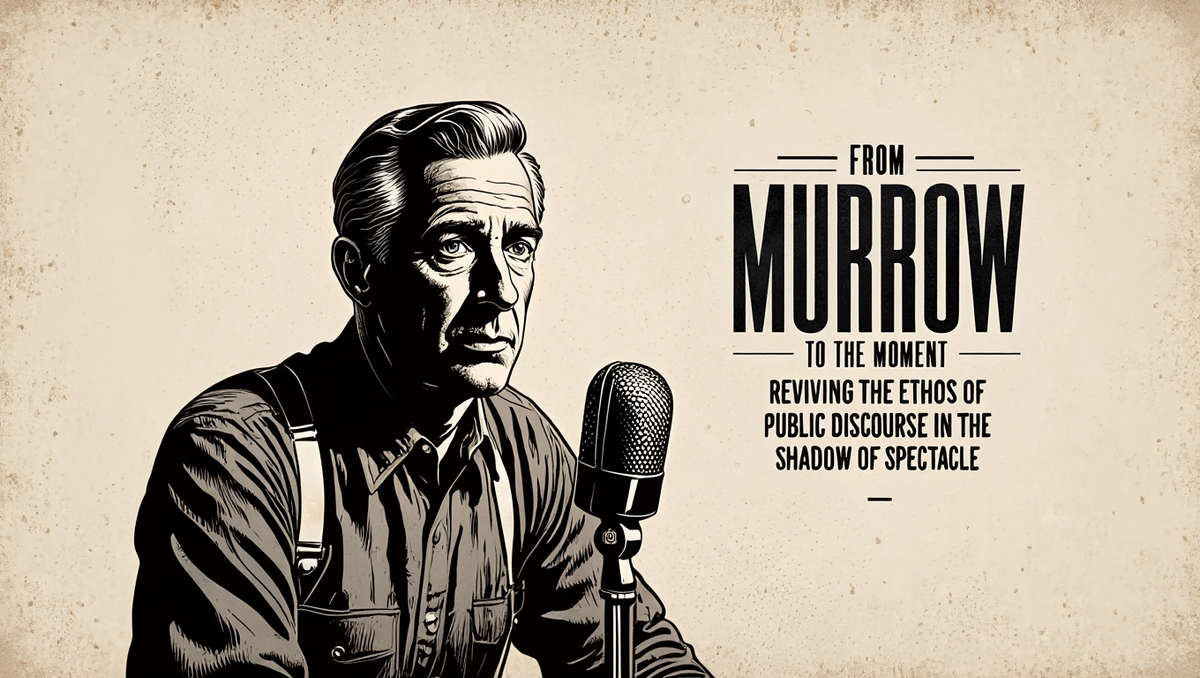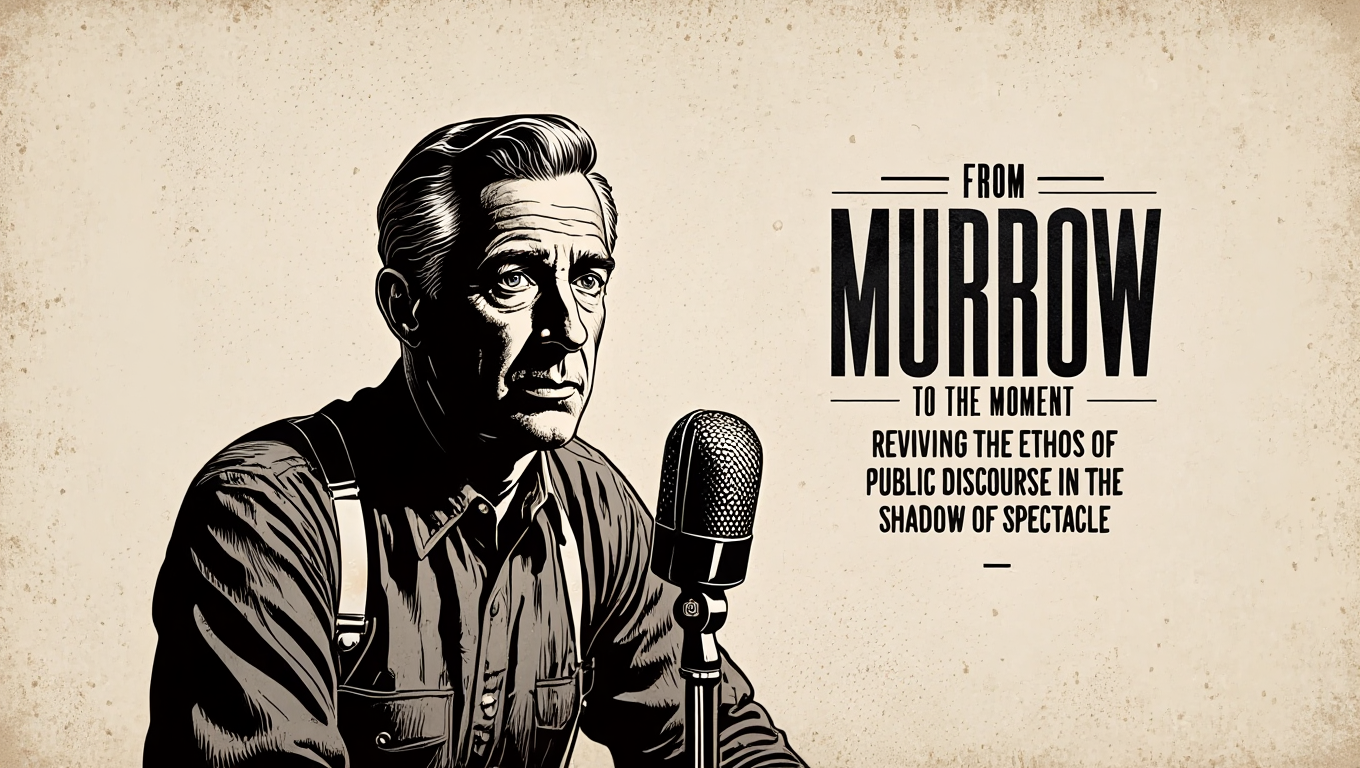From Murrow to the Moment: Reviving the Ethos of Public Discourse in the Shadow of Spectacle
If liberals and conservatives literally perceive moral reality differently, assigning blame, risk, and responsibility through distinct psychological frames, then objectivity becomes less a standard of truth and more a veil of detachment.

Dennis Stevens, Ed.D., Restoring American Public Discourse? (Circa 2014)
In 2014, I made a public call for media transformation grounded in research, civic responsibility, and the moral psychology of political difference.
The moral psychology of political difference draws on the work of scholars like Jonathan Haidt (The Righteous Mind), George Lakoff (Moral Politics), Joushua Greene (Moral Tribes), and Drew Westen (The Political Brain), who explore how deeply held values and cognitive frames shape partisan perception, reasoning, and emotion.
This research challenges journalism’s traditional notion of “objectivity,” which often assumes a neutral, universal lens on truth. But if liberals and conservatives literally perceive moral reality differently—assigning blame, risk, and responsibility through distinct psychological frames—then objectivity becomes less a standard of truth and more a veil of detachment.

In the political moment of 2025—when spectacle eclipses substance and neutrality is weaponized to avoid accountability—journalism must evolve. It must move beyond performative balance and toward moral clarity, contextual truth, and a deeper understanding of the narratives that shape our collective reality.
My initiative, titled Reality Pageant, was not merely a show pitch—it was a comprehensive strategy to reclaim public discourse from the grip of partisan theater and ideological distortion.
Drawing on qualitative research and moral reasoning theory, Reality Pageant proposed a way forward: a program designed not to win debates, but to illuminate the vastly different worldviews that shape them.
This work emerged from a long arc of historical and intellectual developments. It traced the erosion of the Fairness Doctrine, the rise of infotainment, and the rhetorical strategies popularized by Republican figures like Frank Luntz. It named names—from Jude Wanniski to Milton Friedman to the Koch Brothers—situating their influence within a larger shift from civic journalism to corporate persuasion.
Yet, amid this trend, there were notable ruptures in the spectacle: Newton Minow’s warning of a “vast wasteland,” Edward R. Murrow’s stand against McCarthyism, Walter Cronkite’s sobering commentary on Vietnam, and Jon Stewart’s takedown of Crossfire—all moments when journalism briefly reclaimed its duty to inform rather than perform.
In 2014, this was a warning. In 2025, it is a mirror.
George Clooney’s current Broadway production of Good Night, and Good Luck—an adaptation of the film that dramatized Murrow’s battle with McCarthy—is not just nostalgia. It is a cultural diagnosis. As critics have noted, the play resonates in a nation where spectacle has replaced substance, and the tools of truth-telling are again under siege. This is not a coincidence. It is context. The media crisis Murrow confronted—where fear distorted fact, and authority was abused—has returned, only now it wears different colors, deploys algorithms, and performs virality.
In an age eclipsed by spectacle, who dares to speak truth? American journalism must reclaim its purpose—beyond the hollow pretense of objectivity.
The core concern I raised in 2014—that Americans no longer hear each other, not only because they disagree, but also because they perceive reality differently— is now on full display. The same partisan dynamics I analyzed then, particularly how liberal and conservative audiences assign risk and blame, have only deepened. From the rise of authoritarian rhetoric to the weaponization of AI in political communication, the epistemic crisis is no longer looming—it is operational.
What Reality Pageant attempted to offer—a civic, educational, and media-integrated intervention—anticipated this cultural moment. It was a moral call to move beyond performative neutrality and fairness rooted in interpretation and understanding, not explanation and prediction. It was never about restoring some abstract ideal of objectivity. As I stated then, and reaffirm now: objectivity is not the absence of a viewpoint, it is the presence of moral clarity about what fairness requires.
In this sense, Clooney’s Broadway revival becomes more than a tribute to Murrow—it becomes a signal. A signal that echoes what I argued over a decade ago: that democracy requires more than access to information—it requires narrative frameworks that can hold complexity without collapsing into tribalism.
So yes, this is personal.
In 2014, I pitched the urgent need to restore American Public Discourse within CNN as a visionary step forward in adult civic education.
This work aimed to build upon Stewart’s media critique, drew on narrative theory, and integrated insights from cognitive science and moral psychology. It sought to build a bridge, not between pundits yelling on split screens, but between the unspoken values that animate political belief. And it invited viewers to “vote with their dollars” by supporting public-interest media that strive not just to inform, but to illuminate.
That illumination is exactly what Murrow fought for. It is what Clooney now stages. And it is what we, still, must insist upon today.
Hello America, it is nice to meet you. Maybe it's time to do something?
A project of reviving public discourse requires more than better reporting—it demands a deeper understanding of why people believe what they do.
Drawing from moral psychology, media theory, adult learning, and narrative design, my work explores how individuals construct moral meaning through story, emotion, and identity, not just through facts.
Where traditional journalism clings to objectivity as neutrality, I argue for a more honest framework: one that acknowledges the moral foundations that shape political perception, the narrative structures that give beliefs coherence, and the pedagogical methods that allow adults to reframe deeply held assumptions.
This isn't just media reform—it's moral education in a fragmented information age.